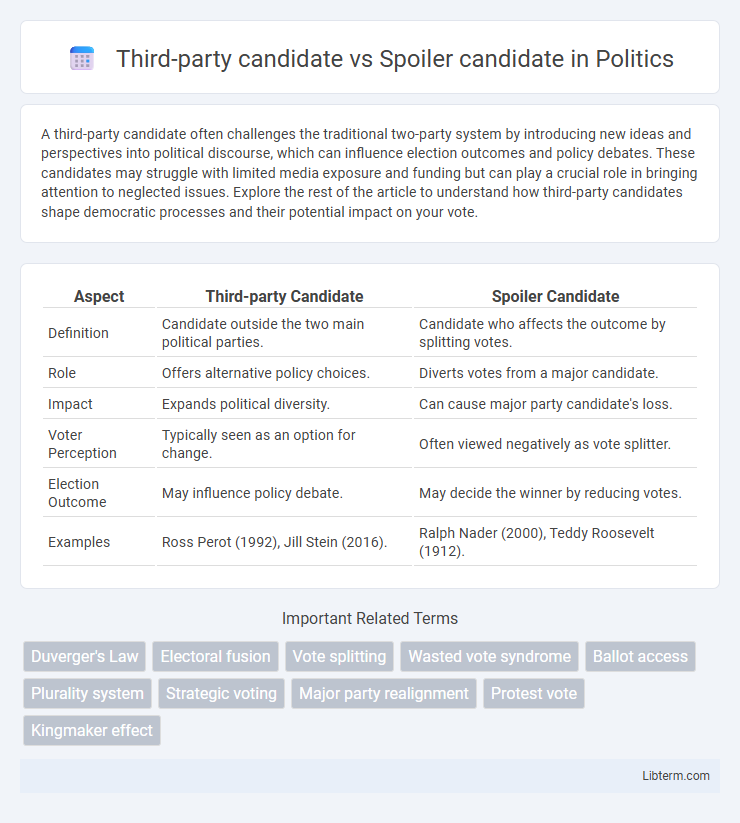A third-party candidate often challenges the traditional two-party system by introducing new ideas and perspectives into political discourse, which can influence election outcomes and policy debates. These candidates may struggle with limited media exposure and funding but can play a crucial role in bringing attention to neglected issues. Explore the rest of the article to understand how third-party candidates shape democratic processes and their potential impact on your vote.
Table of Comparison
| Aspect | Third-party Candidate | Spoiler Candidate |
|---|---|---|
| Definition | Candidate outside the two main political parties. | Candidate who affects the outcome by splitting votes. |
| Role | Offers alternative policy choices. | Diverts votes from a major candidate. |
| Impact | Expands political diversity. | Can cause major party candidate's loss. |
| Voter Perception | Typically seen as an option for change. | Often viewed negatively as vote splitter. |
| Election Outcome | May influence policy debate. | May decide the winner by reducing votes. |
| Examples | Ross Perot (1992), Jill Stein (2016). | Ralph Nader (2000), Teddy Roosevelt (1912). |
Defining Third-Party Candidates
Third-party candidates are political contenders who run outside the two dominant parties, often representing alternative ideologies or specific issues not covered by major parties. Unlike spoiler candidates who primarily influence election outcomes by splitting votes and potentially causing a major party to lose, third-party candidates seek to expand political choices and challenge the existing party system. Their presence can introduce new policy discussions and shift the political landscape beyond merely affecting vote distribution.
Understanding Spoiler Candidates
Spoiler candidates are third-party or independent candidates whose participation in an election can change the outcome by drawing votes away from a major party candidate with similar policies, often leading to the victory of a less preferred candidate. The spoiler effect occurs most notably in plurality voting systems, where splitting the vote between ideologically aligned candidates reduces their chances of winning. Understanding spoiler candidates involves analyzing vote distribution patterns and election results to assess how their presence influences voter behavior and overall election dynamics.
Historical Examples of Third-Party Runs
Third-party candidates such as Theodore Roosevelt in 1912 and Ross Perot in 1992 have significantly impacted U.S. presidential elections by drawing votes away from major party contenders without winning, exemplifying the spoiler effect seen with candidates like Ralph Nader in 2000. Roosevelt's Bull Moose campaign split the Republican vote, enabling Woodrow Wilson's victory, while Perot's independent run highlighted fiscal issues and influenced the election's dynamics. Historical third-party runs demonstrate how these candidates can alter election outcomes and shift national policy debates despite not securing the presidency.
The Spoiler Effect Explained
The spoiler effect occurs when a third-party candidate draws votes away from a major party candidate, potentially altering the outcome of an election by splitting the vote. This phenomenon often results in the election of a candidate who lacks majority support, highlighting the impact of vote distribution within plurality voting systems. Understanding the spoiler effect is crucial for analyzing electoral dynamics and the strategic challenges third-party candidates face in U.S. presidential elections.
Electoral Impact of Third-Party Candidates
Third-party candidates often influence election outcomes by drawing votes away from major party contenders, a phenomenon known as the spoiler effect, which can alter the balance in closely contested races. Their electoral impact varies depending on the political landscape, voter dissatisfaction, and the candidates' ability to mobilize support without winning. In some cases, third-party candidates highlight key issues and shift policy discussions, indirectly shaping major party platforms and electoral strategies.
Media Perceptions of Spoiler vs. Third-Party Roles
Media perceptions often categorize third-party candidates as spoilers when they draw votes away from major party contenders, potentially altering election outcomes. This framing emphasizes the spoiler role by highlighting vote splitting and electoral impact rather than the third-party candidate's platform or potential for systemic change. Coverage tends to marginalize third-party roles by focusing on their disruptive capacity, reinforcing the two-party dominance and shaping public understanding of election dynamics.
Voter Motivations and Third-Party Choices
Voter motivations for choosing a third-party candidate often stem from dissatisfaction with the two major parties and a desire for alternative policy positions, reflecting a search for ideological alignment. Third-party choices can serve as expressions of protest, signaling voter discontent or attempting to influence the political agenda without expectation of winning. The spoiler candidate effect emerges when third-party votes siphon support from a major party candidate, potentially altering election outcomes by splitting the vote in closely contested races.
Election System Influence on Third-Party Success
Election systems heavily impact third-party candidate success, with proportional representation enabling better chances for third parties to gain seats compared to winner-takes-all systems. Spoiler candidates arise primarily in plurality voting systems, where a third-party entrant can split the vote, inadvertently aiding a less-preferred major candidate's victory. Electoral reforms like ranked-choice voting reduce the spoiler effect, allowing third-party candidates to compete without inadvertently benefiting opposing major candidates.
Strategies to Overcome the Spoiler Label
Third-party candidates can counter the spoiler label by emphasizing coalition-building strategies and promoting unique policy platforms that differentiate them from major parties. Strategic voting initiatives and public education campaigns about the value of diverse political representation help reduce the spoiler effect perception. Leveraging ranked-choice voting systems also enables third-party candidates to gain meaningful support without being labeled spoilers.
Third-Party Candidacy: Challenges and Opportunities
Third-party candidacy faces significant challenges such as limited ballot access, lack of media coverage, and inadequate funding, which hinder their ability to compete effectively against major party candidates. Despite these obstacles, third-party candidates offer opportunities to introduce new ideas, influence public discourse, and attract voters dissatisfied with the two-party system. The presence of third-party candidates can reshape electoral dynamics, although they risk being labeled spoiler candidates if their participation divides votes and indirectly affects election outcomes.
Third-party candidate Infographic

 libterm.com
libterm.com